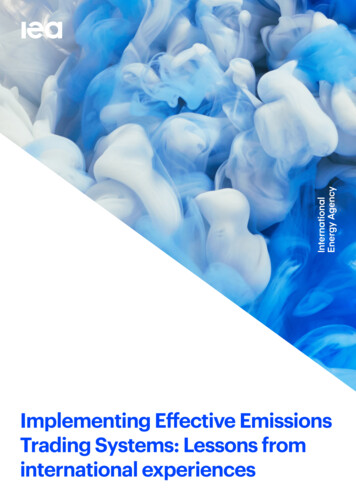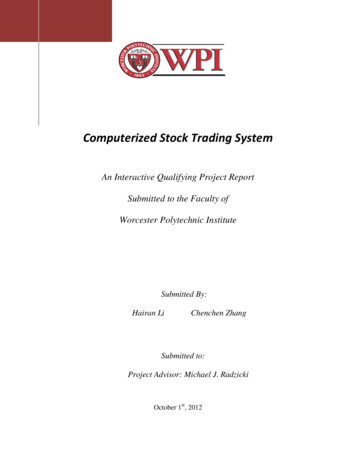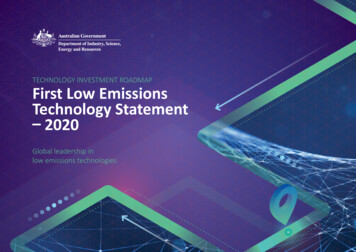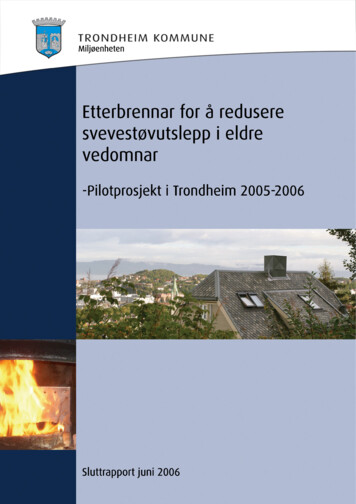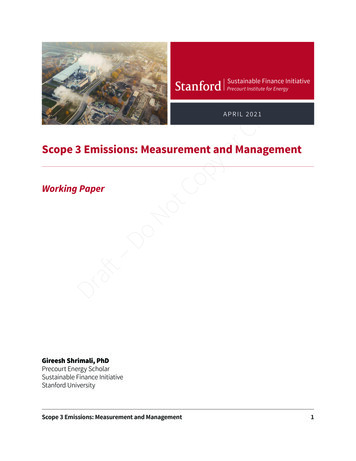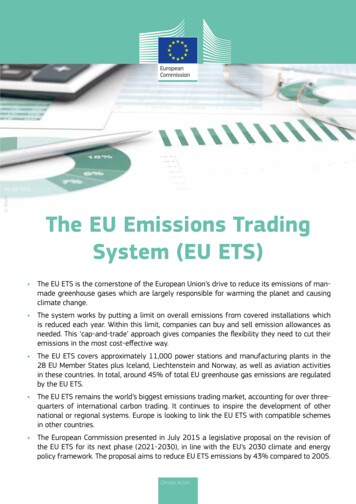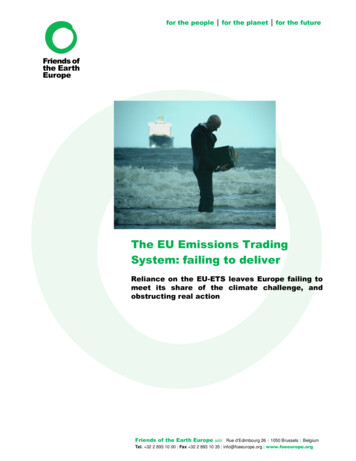
Transcription
for the people for the planet for the futureThe EU Emissions TradingSystem: failing to deliverReliance on the EU-ETS leaves Europe failing tomeet its share of the climate challenge, andobstructing real actionFriends of the Earth Europe asbl Rue d’Edimbourg 26 1050 Brussels BelgiumTel. 32 2 893 10 00 Fax 32 2 893 10 35 info@foeeurope.org www.foeeurope.org
for the people for the planet for the futureTable of Contents3Introduction4Part I: The EU-ETS, and why it’s failing to deliver4567888Over allocation and banking of permitsPrice volatilityFree allocation of permits and industry lobbyingOffsetting is an escape clause for emissions cutsThe wrong tool in times of economic crisisExtending the EU-ETS: a non starterEU-ETS: not fit for purpose10 PART II: Other policy measures1011121213National climate lawsA more ambitious mandatory energy savings targetA higher target for renewable energiesTaxationFinancing emissions cutsWhat Friends of the Earth Europe calls for: End the reliance on the EU-ETS. Priority should be given to other policy options, such asregulation, taxation and subsidies which are able to deliver the scale and speed ofemissions reductions that are necessary to avoid catastrophic climate change. The most dangerous loopholes in the EU-ETS must be removed by ending overseasoffsets, stopping free permits to polluters, introducing a much tighter cap, and preventingthe use of banked permits from earlier phases of the EU-ETS scheme. Auctioning moneymust not be used to subsidise fossil fuels, such as state aid for new coal power plants, orfalse solutions such as nuclear power or CCS. The EU-ETS must not be expanded by either linking with schemes outside of the EU orinstituting sectoral trading with developing countries. Carbon markets cannot be areplacement for mandatory targets under a binding international climate agreement, andadequate and appropriate public funding for climate finance in developing countries. The EU-ETS should not be used as an argument to prevent other policies such as settingbinding energy efficiency targets or to prevent any other measures at national level suchas national climate laws to tackle industry or industry sector emissions.Prepared by Friends of the Earth Europe October 2010Published by Friends of the Earth Europe with the financial support of Friends of the Earthnational member groups, the European Commission, the Oak Foundation and theEuropean Climate Foundation. Sole responsibility for content rests with the author.2/16Printed on recycled paper.
for the people for the planet for the futureIntroductionLaunched in 2005, the European Union’s Emissions Trading System (EU-ETS) is the largestcarbon trading market in the world. It is the EU’s principal policy mechanism for reducinggreenhouse gas emissions in the power generation and industrial sectors. But the EU-ETS isnot delivering the CO2 cuts required by science, historical responsibility and sound financialpractices.The first carbon trading trial phase in 2005-2007 was an abject failure. At 2298 million tons ofCO2, the 2007 cap was actually 8.3% higher than verified 2005 greenhouse gas emissions.Businesses were therefore free to increase emissions – or set emission permits aside for thenext EU-ETS phases. Anxious to avoid having to make short-term investments in emissionsreductions, industry lobbying against higher, effective targets has been extremely effective.In the current 2008-2012 phase, the average CO2 cap is 2% lower than 2005 emissions. Butin seventeen out of twenty-member states – including France, Poland and the UK, 2012caps are still higher than measured emissions in 2005. Overall, twenty-one out of twentyseven member states sought 2012 emissions caps that were higher than 2005 emissions(with the richest EU member state, Luxembourg, pushing for a 52% increase).There are now so many unused permits that most industries covered by the EmissionsTrading System (responsible for almost 50% of EU emissions) can legally avoid making anycuts before at least 2016. What’s more, there is no obligation to reduce emissions in Europe.Through the United Nations’ Clean Development Mechanism, EU-ETS sector businessesmay invest in projects outside Europe. Known as offsetting, this avoids domestic cuts,frequently even fails to reduce emissions in developing countries, and may also causesignificant social and environmental problems.Adding up paltry CO2 emissions caps and offsetting loopholes reveals a dangerous gapbetween science and political reality. The International Panel on Climate Change (IPCC) hasmade it plain that 25-40% emissions cuts will only offer a 50% chance of keeping globaltemperature increases below 2 C. Within the EU, the Netherlands has already budgeted for 100 billion to cope with sea level rises of 1 metre. Yet reports are now warning that a 2 Cincrease could lead to the tipping point beyond which the Greenland ice cap can not survive.This could result in catastrophic 7 metre sea level rises.In this context, ongoing reliance on the Emissions Trading System is a risk that cannot betaken. The EU must urgently increase its emissions target to at least 40% - the upper ‘safe’level set by the IPCC – and ensure that these cuts are domestic. This calls for strong politicalwill. Rather than depend on the uncertain, ineffective, and unfair Emissions Trading System,the EU must privilege other forms of action. This includes tougher laws to developrenewables and increase energy efficiency, as well as carbon taxation and incentives forpublic and private investment to pay for emissions cuts.3/16
for the people for the planet for the futurePart I: The EU-ETS, and why it’s failing to deliverCombating climate change means reducing CO2 emissions. This means decreasingEurope’s use of fossil fuels and supporting increases in energy efficiency, energy savings,and renewable energy. The following section shows how loopholes and design flaws in theEU Emissions Trading System actually work against these goals and are causing social andenvironmental problems in Europe and elsewhere in the world.Over allocation and banking of permitsOver allocationThe purpose of the EU-ETS is to limit the quantity of emissions (by setting a cap) anddistribute the right to emit through a system of tradable permits. But there are far too manyCO2 permits on the European market. To cushion the introduction of a carbon price in 2005,governments pushed for the right to propose how many permits to allocate to their nationalindustries, then overestimated emissions to justify excessive allocations. The result:European Commission figures show that in the first 2005-2007 EU-ETS phase, only threemember states had caps that were lower than baseline 2005 emissions levels. This caused aglut on the allowance market - permit prices crashed to a low of 0.03 per ton in December2007 - and made a mockery of the cap concept. In the second phase, the cap has beentightened, but only by 2% compared to 2005 – far from what is necessary to give a strongprice signal. Seventeen out of twenty-seven member states still have 2012 caps that arehigher than 2005 emissions p2008-2012Capallowed 2008-2012(in relation toproposed)Austria33.033.432.830.7 (93.6%)Belgium62.155.5863.358.5 (92.4%)Bulgaria42.340.667.642.3 (62.6%)Cyprus5.75.17.125.48 (77%)CzechRep.97.682.5101.986.8 (85.2%)Denmark33.526.524.524.5 (100%)Estonia1912.6224.3812.72 6 (94.8%)132.8 (100%)499474482453.1 (94%)MemberStateGermanyExtract from a European Commission press release, 26/10/2007Column two lists 2007 Phase 1 caps; column three 2005 emissions; column four the capsrequested by member states for the 2008-2012 Phase 2 period; column five the compromise dealset by the Commission.4/16
for the people for the planet for the futureBanked permitsEU-ETS rules allow unused CO2 emission permits set aside (‘banked’) during the second(2008–2012) phase to be used in the third 2012–2020 trading period. Over allocation hasbeen so high in the second phase that the campaigning and research organisation Sandbagestimates there are now sufficient spare permits to allow EU industrial and power sectoremissions to grow unchecked until 2016.1Price volatilityBoth big cap and trade schemes in existence today - Europe’s Emissions Trading System forCO2 and America’s market for trading sulphur dioxide permits (to reduce acid rain) - haveshown acute price volatility. The ETS has varied from over 30 to 0.03 in the past fiveyears. Such unpredictability acts as a major deterrent to people investing in renewables andenergy savings / energy efficiency.EU ETS Covered CO2 Emissions and EUA prices 2005-2007Source: Parliamentary Library using EC and PointCarbon dataAccording to the Economist magazine: “Under a cap and trade system, an invention thatreduced the cost of cutting carbon emissions could itself push down the price of permits,reducing investors’ returns”.2 Similarly, higher than expected energy efficiency investments –to lower industrial production costs, for example – could cut energy use and CO2 emissionsbut reduce demand for permits. Hence a ’good’ (cutting CO2 emissions) can be ‘bad’ forpermit prices, killing the incentive for further green investment. In other words, the ETS is acounter incentive to the very goal of emissions reductions that it is designed to achieve.12Sandbag, "Cap or Trap": ap.pdfThe Economist, “Doffing the cap”: http://www.economist.com/node/93376305/16
for the people for the planet for the futureFree allocation of permits and industry lobbyingGreenhouse gas emissions increased in the first EU-ETS phase (2005-2007), clear evidencethat the cap was too high and that there was a massive overabundance of emissions. Yetlittle has been done to close the loopholes. Instead, the Emissions Trading System is actingas a money-making machine for Europe’s biggest companies. Uwe Leprich, fromSaarbrucken University in Germany, has tracked electricity prices since the EU-ETS launchin 2005. His analysis shows that the introduction of CO2 costs was fully included in electricityprices even though energy companies received the majority of their credits for free. This ledto 30% wholesale electricity price increases in Germany and France, 50% in Scandinavia,and over 80% in the UK.3 Poorer households have suffered most as a higher proportion oftheir income is spent on energy. A recent study by Dutch institute CE Delft confirms thesefindings: it estimates that the refining, iron and steel sectors alone generated roughly 14billion between 2005 and 2008 by passing on the costs of freely acquired CO2 allowances.4Not only are businesses not reducing their emissions (thanks to excess permits) but they aremaking extra profits out of the EU-ETS by passing on the costs to consumers. In effect,consumers are paying twice: once for the costs of setting up the carbon market, and onceagain through higher energy bills. The result: the current EU-ETS makes for very profitablebusiness for a few major industries. A successful policy to cut emissions could meanreplacing carbon trading altogether.ScenarioCarbon price20 Euros(a) Power priceincrease 10.9 /MWh(b) Total sales3016 TWh(c) Total cost increase33 Billlion(d) EmissionsreductionsConsumer cost perton reducedNotes(a) x (b)133 Mt 248(c) (d)Allowing Energy Utilities to pass on the costs of freely acquired allowances would lead toconsumers paying 248 costs for each ton of CO2 reduced in the electricity sector.Source: Regulatory Assistance Project (adapted from Sijm, et al, The Impact of the EUETS on Electricity Prices, Final Report to DG Environment,December 2008: ECN-E-08-007)3Uwe Leprich, "The Crisis of the Electricity Markets in in/108/108267.pdf4CE Delft, “Does the energy intensive industry obtain windfall profits through the EU ETS?”:http://www.ce.nl/?go home.downloadPub&id 1038&file 7005 finalreportSdBEV.pdf6/16
for the people for the planet for the futureOffsetting is an escape clause for emissions cutsFor every ton of CO2 emitted in the European Union by the industrial sectors covered by theEU-ETS, polluters must surrender one emissions permit. However, up to 50% of the 2020EU-ETS target (minus 21% compared to 2005 levels) can be met by buying credits throughthe United Nation’s Clean Development Mechanism (CDM). This is known as offsetting:instead of cutting emissions within the EU, Europe-based industries and power companiesmay buy their way out of their obligation to cut emissions by investing in projects whichpurportedly cut emissions in developing countries. In return, they receive CERs, or CertifiedEmission Reduction credits, which are fully interchangeable with EU Allowance Units (EUETS permits) and count towards the 2020 emissions target. Put simply, EU-ETS sectorcompanies are free to buy credits on the international market and continue to pollute inEurope.Offsetting is a critical loophole in the EU’s emissions reduction policy, chiefly because thereis very little atmospheric space left for greenhouse gas emissions. Scientific consensus isthat 25-40% emissions cuts in developed countries would only offer a 50% chance ofkeeping below 2 C. What’s more, this level is increasingly criticised as inadequate to preventthe most devastating consequences of climate change.Domestic emissions reductions of at least 40% by 2020 are needed. But in the 2008-2012EU-ETS phase, authorised levels of offsetting are actually higher than emissions caps. Thismeans that no domestic reductions are required at all. Yet any offsetting of emissions allowsindustrialised countries to continue using the little remaining atmospheric space, denyingdeveloping countries their right to use this space to develop and bring their populations outof poverty. This explains the urgency of reforming the EU’s climate policy to cut domesticemissions in the EU-ETS sector in line with scientific evidence and provide additional publicfinancing for emissions reductions in developing countries.Offsetting, moreover, is cruciallydependent on the success andviability of CDM projects. Yet thesystem is regularly rocked by marketscandals – most recently by theproduction / destruction of HFC-23, anozone-depleting by-product of therefrigerant gas HCFC-225. As HFC-23isalsoanextremelypotentgreenhouse gas (11,700 times morethan CO2), its destruction is eligible forCDM funding and the resulting creditsmay be used to meet the offsettingshare of the EU’s Emissions TradingSystem. The destruction of each tonof HFC-23 generates 11,700 credits(issued on a CO2 equivalent basis)which are worth about 150,000 on5Misuse of Clean Developmet Mechanism funding is anincreasing concern: Eskom, a South African electricityutility, created a scandal in June 2010 by announcingthat it would seek CDM financing for the construction ofMedupi Coal Power Station.CDM Watch, "HFC-23 Offsets in the Context of the EU Emissions Trading Scheme": http://www.cdmwatch.org/?p 10657/16
for the people for the planet for the futurethe ETS market (with the current 2010 spot price of 13). Meanwhile, the real cost ofdestroying HFC-23 is an astonishing seventy times less, at roughly 2000 per ton. Theresult: industries (mostly in India and China) are deliberately increasing HCFC-22 productionwith the primary intent of churning out, then destroying, ever greater amounts of HFC-23.Fuelled by the EU-ETS market, the Clean Development Mechanism is incentivisingcompanies to create greenhouse gases purely so that they can then be paid to destroy them.Even looking beyond these scandals, many of the other projects funded by the CleanDevelopment Mechanism frequently fail to reduce emissions in developing countries, andmay also cause significant social and environmental problems.6The wrong tool in times of economic crisisSolving the climate crisis requires a speedy transition to a low consumption, renewablebased energy system, but it is also a superb opportunity to build a fairer and more resilienteconomy. The Emissions Trading System isn’t up to this new green deal. Offsetting and theover allocation of permits mean that there is simply no obligation to finance emissions cutsand move to a green energy system. This is at a time when the EU urgently requires largeinfrastructure investments, such as modernised electricity grids, up-front financing for energyefficiency and greatly accelerated renewable energy development.Extending the EU-ETS: a non starterThe European Commission has plans to expand the EU-ETS by linking it up with othernational cap and trade schemes. The intention is to include Australia, Japan, New Zealand,and the United States by 2015, and to set up an even broader market by 2020. But there aremany practical and deep-rooted reasons not to extend such an unsuccessful scheme. First,a single trading partnership assumes a free flow of emissions credits in a multinationalcarbon market – but standards within each regional and national system could be verydifferent. This risks a race to the bottom: the country with the lowest standards (for instancehigh percentages of poorly verified offsetting) would effectively set the benchmark foreveryone else. Second, greenhouse gas concentrations are rapidly increasing: time is of theessence and there is no room for error in policy decisions. Even at present rates of fossil fueluse, the 2 C temperature ceiling – which the EU pledged in 2005 to meet - will be breachedin the next fifteen years. Finally, any increase in the scale of the carbon markets is also likelyto popularise the use of highly complex financial instruments – risking a burst carbon bubblewith far greater economic, political and environmental consequences than the subprimecrash.76Friends of the Earth "A Dangerous angerous obsession.pdf7Friends of the Earth US, "Subprime Carbon": http://www.foe.org/subprimecarbon8/16
for the people for the planet for the futureEU-ETS: not fit for purposeIn an increasingly urgent environmental situation, the Emissions Trading System is notdelivering emissions cuts. Policymakers can make fundamental changes to the way the EUETS works: excluding offsetting, stopping free permits to polluters, setting a much tightercap, and preventing the use of banked permits from earlier phases of the scheme. But theymust also consider a return to other important policy mechanisms which are currently beingovershadowed by carbon trading, such as budgetary reform, tougher renewable and energysaving targets, CO2 taxation, efficiency standards and national legislation. Only by doing socan Europe bring down its emissions in line with scientific evidence and historicalresponsibility.What Friends of the Earth Europe calls for: The most dangerous loopholes in the EU-ETS must be removed by ending overseasoffsets, stopping free permits to polluters, introducing a much tighter cap, andpreventing the use of banked permits from earlier phases of the EU-ETS scheme.Auctioning money must not be used to subsidise fossil fuels, such as state aid for newcoal power plants, or false solutions such as nuclear power or CCS. The EU-ETS must not be expanded by either linking with schemes outside of the EUor instituting sectoral trading with developing countries. Carbon markets cannot be areplacement for mandatory targets under a binding international climate agreement,and adequate and appropriate public funding for climate finance in developingcountries.9/16
for the people for the planet for the futurePART II: Other policy measuresMore than simply delaying or avoiding action on climate change, the choice to invest somuch political capital in the EU-ETS is obstructing other tried and tested measures thatwould lead to more certain results. The following section details some of these other policymeasures, shows how they could achieve what the EU-ETS is failing to deliver, and alsoexplains how the EU-ETS is obstructing their implementation.National climate lawsClimate legislation at national level can both stimulate action in the absence of ambitiousEuropean Union targets, and increase the EU’s overall ambition. Examples of progressiveclimate legislation already exist in the UK, and legislative proposals for national climate lawsare being debated by governments and parliaments across Europe.Friends of the Earth Europe’s pan-European climate campaign (the ‘Big Ask’) is calling for: National climate laws with legally binding targets for annual emission cuts across allsectors Direct penalties for EU member states which do not reduce their emissions year byyear The EU to deliver its fair share of the finances and technology needed by developingcountries to tackle climate change.Annual targets make it easier to measure progress towards medium and long-term emissionreductions and ensure that these cuts start happening rapidly. They also help fix problemshighlighted in Part 1, creating a positive and stable context for investment, allowing long termplanning and innovation and ensuring a smooth transition to an environmentally, socially andeconomically sustainable economy.8In parallel, national compliance mechanisms are needed to place appropriate sanctions ongovernment departments, regions and sectors that fail to meet their targets. Nationalmeasures must be linked up with EU-wide infringement procedures to penalise countries thatfail to meet national targets.Overreliance on the EU-ETS is currently standing in the way of strong national climatelegislation. The power and industry sectors covered by the EU-ETS are arguing – andlobbying their governments to support them – that it would be unfair to add additionallegislation to current climate objectives. Yet this ignores the disturbing mismatch betweenEU-ETS sector objectives and real world environmental needs. Climate legislationincorporating higher targets, energy efficiency standards, energy or CO2 taxation andincentives for innovation can be introduced at national level without coming into legal conflictwith the EU ETS. In other words, implementing strong and fair climate laws is a question ofpolitical will, rather than legal obstacles.8Friends of the Earth Europe, “The Big Ask”: http://www.thebigask.eu10/16
for the people for the planet for the futureA more ambitious mandatory energy savings targetAlternatives to the Emissions Trading System must be simpler to execute, and have a moredirect impact on emissions reductions and economic recovery. With roughly 75% of the EU’senergy supply coming from fossil fuels, reducing energy consumption clearly fits the bill.The European Commission has highlighted the benefits of bringing energy consumptionback down to 1990 levels: over 200 billion annual savings in energy bills between now and2020, hundreds of thousands of new jobs (through industrial upgrades, energy andtelecommunicationsservices,buildingretrofits) and 800 million tons of CO2reductions (equivalent to 20% cuts below2005 levels). Meanwhile, by scaling back itsenergy requirements, Europe would alsocounter its growing dependency on externalenergy suppliers(importdependencycurrently exceeds 50% of European energyconsumption). Put simply, while the EU’sCO2 emissions targets set the level ofambition, it is the energy savings - andrenewables – objectives which deliver theSmart meters like this “Wattson” (by DIYresults.Kyoto) save energy by raising consumerawareness: the Wattson changes colourdepending on household consumptionlevelsBut this interdependence between climateand energy policies has been pushed asideby excessive faith in the Emissions TradingSystem. Despite its clear benefits, the current2020 savings objective (which includes theEU-ETS sector) is a purely voluntary affairthat member states – with no mandatory legislation to ensure compliance - have largelyignored. The EU must step up its energy savings policy in the coming months. A mandatorysavings target in the EU-ETS sector would combine efficiency with transparency, eliminatingthe risk of offsetting scandals or misjudged emission caps. Results would be measured bysimply comparing year by year energy consumption. Despite claims from some businesslobby groups that introducing efficiency targets in the ETS sector would be unfair, industrytoo, would gain: mandatory energy efficiency standards can push down production costs andlead to more efficient and competitive products. The EU is currently debating whether to setmandatory energy savings legislation: it should not hesitate to do so – nor to think moreambitiously than 20% by 2020.11/16
for the people for the planet for the futureA higher target for renewable energiesThe simplest way of reducing emissions is to cut energy use. But alongside higher efficiencystandards, the EU must accelerate the transition to a renewable based energy system.Fossil fuel power generation is not only a massive source of greenhouse gas emissions, it isalso extremely inefficient: coal, oil (and nuclear) power plants convert little more than 30% ofthe primary resource - coal, uranium - into electricity. The remainder is lost in thetransformation process - typically in the form of waste heat. In comparison, with mainstreamrenewables such as wind and solar, there is no cost or CO2 content to unused resources.Renewables fluctuate with changing weather patterns but this can be solved bystrengthening regional interconnections and storage capacity. Renewables, moreover,counter the extreme price volatility of international oil and gas prices and reduce the EU’sdependence on external energy supplies - Europe currently imports over 80% of its oil and60% of its gas requirements. The EU has everything to gain from increasing its renewablestarget beyond the current objective of 20% of energy use by 2020.TaxationCompared to cap and trade schemes, taxation is simpler and far more transparent. First,having a fixed price for CO2 offers investment security to businesses and the public (unlikethe EU-ETS, which as noted in Part 1 has seen extreme price fluctuations).Secondly, taxation removes uncertainty: the Emissions Trading System has shown that it istoo easy to misjudge the number of permits. Conversely, if a tax when introduced is too lowto stimulate change, it can be increased with relative ease – and in any case it makes goodpolitical sense to start low and work upwards. For example, Sweden’s escalating carbon taxwas introduced in 1991at a rate of 28 per ton but is now over 100 per ton, and thecountry’s Ministry of Finance estimates that emissions would be 20% higher without the tax.Thirdly, taxation both induces and funds emissions reductions. The perfect carbon tax wouldcause an immediate shift away from CO2 intensive activities but in the real world there is atime lag, especially for capital intensive products such as power plants which take acomparatively long time to be replaced (compared to low consumption light bulbs orhousehold insulation, for instance). This gap between setting a tax and achieving changeprovides government revenue for energy efficiency and renewables to cut emissions.Fixing EU taxation by revising energy taxes to focus on CO2 emissionsEuropean Union energy taxation is currently worth 240 billion per year. Properly used,taxation is both a powerful tool to enforce emissions reductions and a major source offunding. However, “the EU only taxes energy when it is used as fuel or for heating, and notas raw materials in industrial processes, or as input in the making of other energy products(in refineries) or even as inputs for electricity generation”.9 Consequently, the EU-ETS sectoris exempted from energy taxation. What’s more, EU taxation currently focuses on the energycontent of fuels rather than CO2 values, making no distinction, for instance, between fossil9David Buchan, "Energy and Climate Change, Europe at the crossroads": Oxford University Press12/16
for the people for the planet for the futurefuel and renewable power generation. The alternative is to redirect EU energy taxation: tofine CO2 intensive fuels and include the EU-ETS sector, thus giving power companies andindustry a powerful incentive to change business models and cut emissions.Barriers and opportunities: Making taxation workUntil now, stiff industry resistance has held off EU-coordinated CO2 taxation in favour of thesofter EU-ETS alternative. It has even led to regressions: Sweden had to phase out taxationin the manufacturing sector to comply with EU-ETS rules. But opposition is exaggerated. TheUK is the EU’s staunchest opponent to common taxation but it already has a form of carbontaxation with the Climate Change Levy. Denmark, Finland, Ireland, the Netherlands,Sweden and Norway (which complies with many EU regulations) also have carbon taxes.Crucially, the point is not to ramp up overall taxation, but simply to readjust taxes towardsCO2 intensive sectors. Denmark, for example, offers tax rebates to companies willing toinvest in energy savings, renewables and other measures to cut emissions.Another serious concern is to ensure that the polluter pays. For this, strict regulation isneeded to avoid extra costs of taxation being passed onto consumers (as so often occurswith EU-ETS permits). Similarly, policymakers must make certain that taxation does notpenalise poorer households with less financial capacity to respond to CO2 price incentives(house insulation costs, for instance, are a major barrier without grants, low interest loansand other support schemes). Modelling by the Institute for Public Policy Research showsthat, without adjustment, those in the lowest income decile would, in proportional terms losealmost four times as much from a carbon tax as those in the highest decile.10Financing emissions cutsAs noted in Part 1, the urgency of tackling clima
Price volatility Both big cap and trade schemes in existence today - Europe’s Emissions Trading System for CO 2 and America’s market for trading sulphur dioxide permits (to reduce acid rain) - have shown acute price
